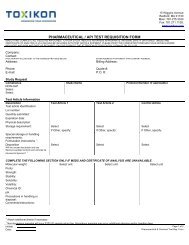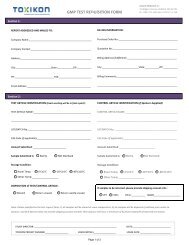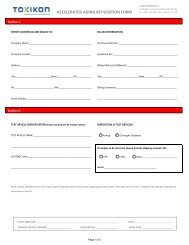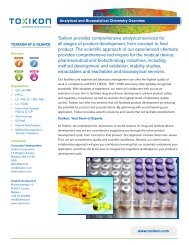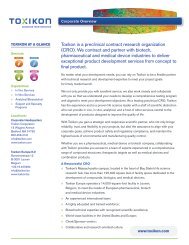Medical Device Testing Guide - Toxikon Corporation
Medical Device Testing Guide - Toxikon Corporation
Medical Device Testing Guide - Toxikon Corporation
Create successful ePaper yourself
Turn your PDF publications into a flip-book with our unique Google optimized e-Paper software.
IMPLANTATION TESTS—ISO 10993-6<br />
Rev. May 2011<br />
PURPOSE: Implant studies evaluate the local pathological effects on living tissue, at both the gross and microscopic level of a<br />
test article that is implanted into an appropriate implant site. Standard implant sites include muscle, bone, subcutaneous,<br />
intraperitoneal, and brain. The test is typically performed in albino rabbits but other species are available. Studies can be<br />
customized based on species, animal number, implant site, duration and evaluation criteria.<br />
For resorbable/degradable materials, time points selected for evaluation in animals should be related to the estimated<br />
degradation time of the test material as determined from in vitro degradation studies. In addition, pilot studies in rodents<br />
should be done to determine the expected rate of degradation prior to studies in larger animals. Implant studies of<br />
resorbable/degradable materials, should evaluate local tissue responses relative to the overall degradation process as<br />
represented by multiple time points including: a) When there is minimal or no degradation, b) When degradation is occurring,<br />
and c) When a steady state has been reached, resulting in tissue restoration or degradation nearing completion. The Sponsor is<br />
responsible for determining degradation and specifying relevant time points for evaluation in animals. When notified of<br />
resorbable/degradable materials requiring implantation, sites are implanted with a suitable marker (i.e. non-absorbable suture)<br />
to aid in identification of the implant site at the end of the designated time periods and addition cost changed to Sponsor. A<br />
predicate control material, if available, is recommended to be specified/supplied by the Sponsor.<br />
Sample requirements listed are based on one test material. Test articles with multiple components require evaluation of each<br />
selected or specified patient contacting component.<br />
AH01-2<br />
AH01-4<br />
AH01-6<br />
AH01-8<br />
AH01-12<br />
AH01-13<br />
AH01-26<br />
AH01-52<br />
Muscle Implant<br />
2 Week Implant-Sample needed per material: 18 strips at 1mmx1mmx10mm<br />
4 Week Implant- Sample needed per material: 18 strips at 1mmx1mmx10mm<br />
6 Week Implant- Sample needed per material: 18 strips at 1mmx1mmx10mm<br />
8 Week Implant- Sample needed per material: 18 strips at 1mmx1mmx10mm<br />
12 Week Implant- Sample needed per material: 18 strips at 1mmx1mmx10mm<br />
13 Week Implant- Sample needed per material: 18 strips at 1mmx1mmx10mm<br />
26 Week Implant- Sample needed per material: 18 strips at 1mmx1mmx10mm<br />
52 Week Implant- Sample needed per material: 18 strips at 1mmx1mmx10mm<br />
The muscle implantation test assesses the material or device for local effects on living tissue when implanted typically in the<br />
paravertebral muscles of the rabbit. The bioreactivity of a material is evaluated both macroscopically and microscopically<br />
through a comparison of the tissue response caused by the material or device as compared to an appropriate control material<br />
(i.e. negative control plastic or predicate control). At the end of the observation period, gross observations of the implant sites<br />
will be recorded. The area of the tissue surrounding the center position of each implant strip will be processed and a<br />
pathologist will process the implanted sites for histopathological evaluation. Inflammation, fibrosis, haemorrhage and necrosis<br />
are evaluated on a scale and compared to the control article sites.<br />
Approximate turnaround time is duration of implant period + four to five weeks.<br />
AH02-2<br />
AH02-4<br />
AH02-6<br />
AH02-8<br />
AH02-12<br />
AH02-13<br />
AH02-26<br />
AH02-52<br />
Subcutaneous Implant<br />
2 Week Implant- Sample needed per material: 18 strips at 1mmx1mmx10mm<br />
4 Week Implant- Sample needed per material: 18 strips at 1mmx1mmx10mm<br />
6 Week Implant- Sample needed per material: 18 strips at 1mmx1mmx10mm<br />
8 Week Implant- Sample needed per material: 18 strips at 1mmx1mmx10mm<br />
12 Week Implant- Sample needed per material: 18 strips at 1mmx1mmx10mm<br />
13 Week Implant- Sample needed per material: 18 strips at 1mmx1mmx10mm<br />
26 Week Implant- Sample needed per material: 18 strips at 1mmx1mmx10mm<br />
52 Week Implant- Sample needed per material: 18 strips at 1mmx1mmx10mm<br />
The subcutaneous implantation test assesses the material or device for local effects on living tissue when implanted<br />
subcutaneously in rabbits. The bioreactivity of a material is evaluated both macroscopically and microscopically through a<br />
comparison of the tissue response caused by the material or device as compared to an appropriate control material (i.e. negative<br />
control plastic or predicate control). At the end of the observation period, gross observations of the implant sites will be<br />
recorded. The area of the tissue surrounding the center position of each implant strip will be processed and a pathologist will<br />
process the implanted sites for histopathological evaluation. Inflammation, fibrosis, haemorrhage and necrosis are evaluated on<br />
a scale and compared to the control article sites.<br />
Approximate turnaround time is duration of implant period + four to five weeks.<br />
15 Wiggins Avenue, Bedford, MA 01730 781.275.3330 www.toxikon.com



